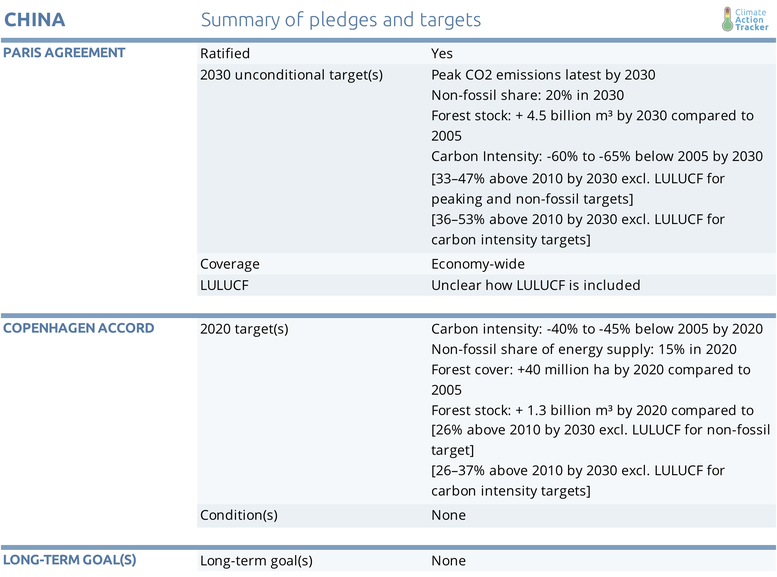Pledges And Targets
Summary Table

Paris Agreement targets
On 3 September 2016, China ratified the Paris Agreement and submitted its NDC to the UNFCCC, which includes a number of elements:
- Peak CO2 emissions by 2030, or earlier if possible;
- Increase the share of non-fossil energy sources in the total primary energy supply to around 20% by 2030;
- Lower the carbon intensity of GDP by 60% to 65% below 2005 levels by 2030;
- Increase the forest stock volume by around 4.5 billion cubic metres, compared to 2005 levels.
Among measures to implement enhanced actions on climate change, it also lists the following elements:
- Increase the share of natural gas in the total primary energy supply to around 10% by 2020;
- Proposed reductions in the production of HCFC22 (35% below 2010 levels by 2020 and 67.5% by 2025) and “controlling” HFC23 production by 2020.
China’s environmental minister Li Ganjie has indicated that China will update its NDC by 2020 (Darby, 2019b).
2020 pledge
China’s 2020 pledge consists of the following elements:
- Overall reduction of CO2 emissions per unit of GDP by 40–45% below 2005 levels by 2020;
- Increase the share of non-fossil fuels in primary energy consumption to around 15% by 2020;
- Increase forest coverage by 40 million hectares and forest stock volume by 1.3 billion cubic metres by 2020 from 2005 levels.
We analysed the effects of all these targets – if achieved - on emissions, including the non-fossil target for 2020 and 2030. For details of how we quantify China’s NDC targets, please see the assumptions section.
Long-term strategy
China has not yet submitted a long-term strategy to the UNFCCC, but China’s environmental minister Li Ganjie has indicated that China will communicate its long-term strategy by 2020 (Darby, 2019a).
Further analysis
Latest publications
Stay informed
Subscribe to our newsletter




